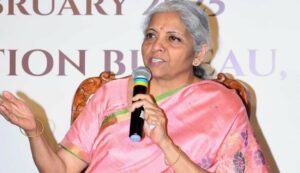Nirmala Sitharaman: India must be prepared to meet challenges and take advantage of opportunities
San Francisco: Nirmala Sitharaman, Union Minister of Finance and Corporate Affairs, said that India had to be ready to take on possibilities and overcome obstacles in the face of a shifting global order.

Speaking on ‘Laying the Foundations for a Developed India – Viksit Bharat by 2047’ at Stanford University’s Hoover Institution in California, Sitharaman highlighted the need to maintain a commitment to long-term national objectives while keeping cognizant of present circumstances.
She said, “We must remain dedicated to long-term objectives while keeping an eye on the here and now as we build the framework for a prosperous India. The world order is evolving. That presents opportunities as well as problems. While capturing the latter, we must be ready to take on the former.
Additionally, the minister emphasized that social inclusion, environmental sustainability, economic development, and job creation are all national concerns and do not conflict with one another. Rather, they are related objectives that need to be worked towards in tandem.
According to Sitharaman, the government cannot achieve the goal of a Viksit Bharat (Developed India) on its own. Every citizen will need to work together to accomplish it.
“This vision calls upon us to think boldly, act inclusively, and stay resilient and flexible,” she said.
She also emphasized how the Indian diaspora contributes to the world economy. She cited a study by Indiaspora and BCG that indicated 72 unicorns, or businesses worth more than $1 billion USD, were formed by first-generation Indian immigrants between 2018 and 2023. Together, these businesses were worth at least USD 195 billion and employed close to 55,000 people.
According to Sitharaman, the headquarters of more than 65% of India’s Global Capability Centers (GCCs) are located in the US. These facilities provide valuable services, including audits, management consulting, and research and development.
She admitted that India’s start-up journey is still in its infancy, while the US has had a developed start-up environment for more than 50 years.
However, by eliminating barriers connected to infrastructure and regulations, the Indian government has concentrated on lowering the risk and expense of launching new companies during the last 10 years.
India’s ambition to become a developed country by 2047 is a shared national objective that is fueled by development that is inclusive, sustainable, and innovation-led. India’s solid macroeconomic foundations and steady reforms over the last ten years have kept the nation on course despite international upheavals like the pandemic and financial crises.
She also highlighted the government’s efforts to build infrastructure, which have boosted investor confidence and established a strong basis for growth driven by manufacturing.
According to the minister, “As a result, India has risen from the world’s tenth-largest economy to the fifth-largest, a clear sign of our growing strength and global relevance.”
She stated that the Union Government’s capital expenditures more than quadrupled between 2017–18 and the 2025–26 Budget, enabling this development. Sitharaman’s formal visit to the United States started on April 20 and will last for five days.

